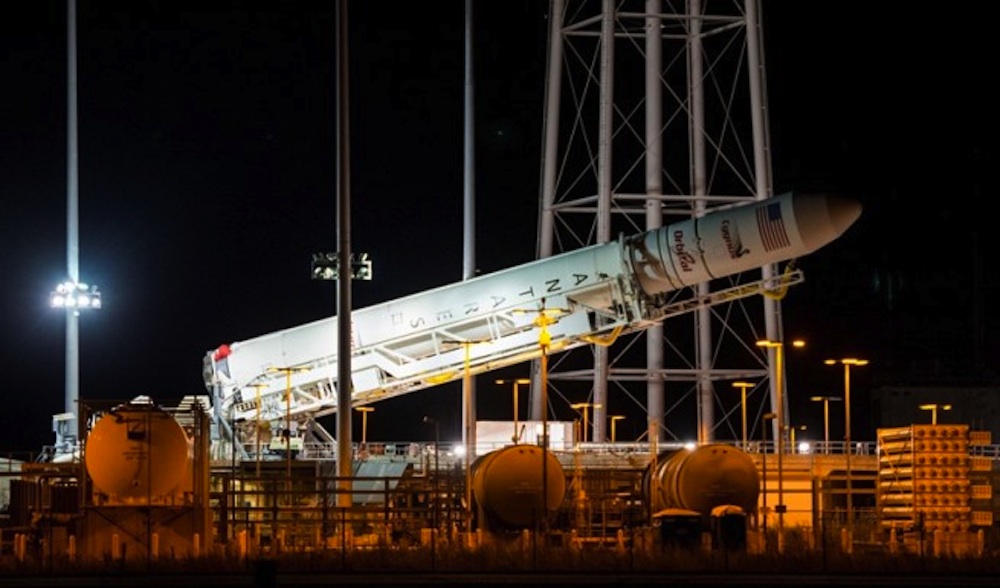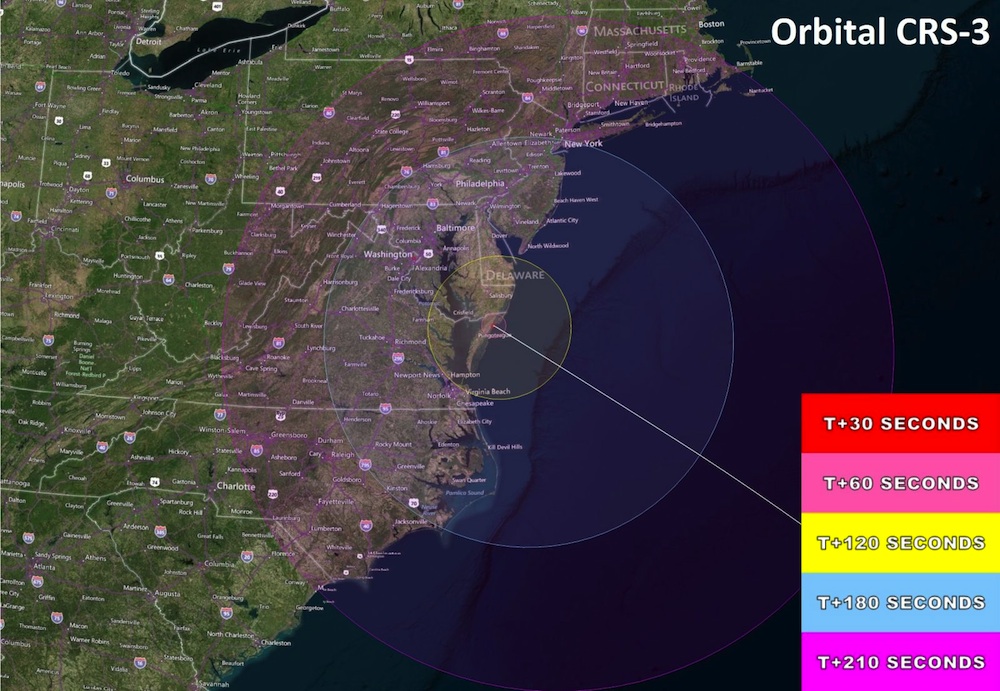After launch had been rescheduled a number of times, and then last week’s hurricane Gonzalo threatening a key NASA ground station in Bermuda, NASA announced on October 22 that the Orbital Sciences 3 (Orb-3) mission was a ‘go’ for launch on Monday, October 27, 2014. Liftoff of Orb-3, carrying the SSEP Mission 6 to ISS Yankee Clipper payload of 18 experiments, is scheduled for 6:45 pm ET, from Pad 0-A at the Mid-Atlantic Regional Spaceport (MARS), Wallops Island, VA. MARS is a commercial spaceport adjacent to the Wallops Flight Facility operated by NASA’s Goddard Space Flight Center. The launch of Orb-3 will be visible over a large swath of the Eastern Seaboard (see graphic below).
The SSEP Yankee Clipper payload is part of the 5,000 lbs of cargo being transported to the International Space Station by the Cygnus spacecraft, which sits atop the Antares rocket. The Orb-3 Cygnus spacecraft has been named the SS Deke Slayton in honor of Mercury 7 astronaut Donald “Deke” Slayton.
To the thousands of students, teachers, administrators, and organizational partners that made Mission 6 to ISS possible across the U.S. and Canada, a huge congratulations. And yes, this is an international SSEP Mission. We are honored to welcome our second Canadian community into SSEP – Kamloops/Thompson, British Columbia. SSEP for international communities is overseen by the Arthur C. Clarke Institute for Space Education, the international arm of the National Center for Earth and Space Science Education in the U.S.
WATCH LIVE RIGHT HERE ON THE NASA TV PORTAL BELOW
You are invited to watch LIVE on NASA TV, in the NASA TV portal below, the Pre-Launch and Science Briefings on Sunday October 26, the Launch of Orb-3 and Post-Launch Briefing on Monday October 27, and Cygnus arrival at ISS on Monday November 2. Remember to bookmark this page. Also below is the October 22, 2014, NASA Press Release on the flight of Orb-3, which provides an overview of milestone events, cargo, and NASA TV coverage. You are also invited to read the Orbital Sciences October 22, 2014, Orb-3 Mission Update.
Some milestones covered live on NASA TV:
Sunday, October 26:
Pre-Launch Briefing, 1:00 pm ET
Science Briefing: 2:00 pm ET (SSEP Director Dr. Jeff Goldstein is on panel)
Monday, October 27:
Launch: coverage begins 5:45 pm ET for launch at 6:45 pm ET
Post-Launch Briefing: coverage begins about 90 minutes after launch
November 2: Grapple of Cygnus at ISS: coverage begins 3:30 am ET for a grapple at 4:58 am ET
We have 150 SSEP students, teachers, administrators, family members, and other stakeholders attending the launch of Orb-3, representing 8 Mission 6 communities: Washington, D.C.; Kalamazoo, MI; Berkeley Heights, NJ; Ocean City, NJ; Colleton County, SC; North Charleston, SC; Knox County, TN; and Somerville, TN. There will be 41 SSEP student researchers in attendance representing 8 of the 18 Mission 6 flight experiment teams.
NASA has invited the National Center for Earth and Space Science Education to present a formal SSEP Briefing to the media on launch day, October 27, from 3:30 – 5:00 pm ET. Note this will not be covered live on NASA TV. Dr. Jeff Goldstein, SSEP Program Director, will first provide an overview of SSEP. followed by presentations by each of the 8 flight teams. Flight teams will also be presenting at a poster session in the Wallops Flight Facility Visitor Center, and will be available for media interviews.
MEDIA PACKAGE Downloadable Documents (PDFs)
SSEP National Program Overview for Congressional Briefings on Capitol Hill
Mission 6 to ISS Profile
Mission 6 Flight Experiments Summary Table
Mission 6 Flight Experiments: Research Teams and Experiment Summaries
NCESSE Official Response to Sen. Tom Coburn
NASA has also invited all SSEP delegations to attend the formal Orb-3 Pre-Launch and Science Briefings on Sunday October 26, and the Post-Launch Briefing on Monday October 27, all of which will be covered live on NASA TV.
Current plans are for SSEP delegates to view the launch from the end of Arbuckle Neck Road, which is just 1.7 miles from Launch Pad 0-A. By comparison, the Wallops Flight Facility Visitor’s Center, which is the primary public viewing site for launches, is located 7.5 miles from the Pad (see Map).
The schedule of all SSEP launch activities for delegations at Wallops can be found on the Orb-3 Launch Viewing Plans page.
Mission 6 Historical Data: The 18 experiments flying as the SSEP Yankee Clipper payload reflect the 18 communities participating in Mission 6 to ISS. Program operations in all communities began on February 24, 2014. Microgravity experiment design and proposal writing was conducted over the course of 9 weeks, February 24 through April 28, 2014. Across the communities, a total of 6,860 grade 5-15 students were fully engaged in microgravity experiments design and 1,487 proposals were received from student teams. The selected flight experiment for each community was determined by the SSEP National Step 2 Review Board that met at the Smithsonian National Air and Space Museum on May 20 and 21, 2014. In the intervening months, all flight experiments underwent NASA Flight Safety Review and passed, flight experiment teams continued to optimize their experiments, and experiment lock-in for flight configuration occurred on August 1, 2014. Flight and ground truth mini-laboratories were loaded, and the flight experiments arrived at NanoRacks in Houston by September 26, 2014. NanoRacks heat-sealed 2 poly bags around each mini-lab for a required additional 2 levels of containment, and carried out payload integration into the Yankee Clipper payload. The payload boxes were then handed over to NASA for integration into the Orb-3 Cygnus vehicle SS Deke Slayton.
NASA Press Release: October 22, 2014
NASA Television Coverage Set for Orbital Resupply Mission to Space Station
Orbital Sciences Corp. will launch its next mission to resupply the International Space Station Monday, Oct. 27, and NASA Television will broadcast live coverage of the event, including pre- and post-launch briefings and arrival at the station.
Orbital Science’s Cygnus cargo carrier is transported Oct. 16, 2014 from the NASA fueling facility on Wallops Island, Virginia to the Horizontal Integration Facility where it will be mated to the Antares rocket for the Orbital CRS-3 cargo mission to the International Space Station.
Orbital Science’s Cygnus cargo carrier is transported Oct. 16, 2014 from the NASA fueling facility on Wallops Island, Virginia to the Horizontal Integration Facility where it will be mated to the Antares rocket for the Orbital CRS-3 cargo mission to the International Space Station.
Image Credit: NASA/Jamie Lee Adkins
Orbital’s Cygnus cargo spacecraft is scheduled to launch at 6:45 p.m. EDT from the Mid-Atlantic Regional Spaceport’s Launch Pad 0A at NASA’s Wallops Flight Facility in Virginia. Launch coverage begins at 5:45 p.m.
A prelaunch status briefing will be held at 1 p.m. Sunday, Oct. 26, followed at 2 p.m. by a briefing to preview the mission’s science cargo. A post-launch briefing will be held approximately 90 minutes after liftoff.
Media who wish to ask questions remotely during the briefing must respond to Rachel Kraft at rachel.h.kraft@nasa.gov no later than 30 minutes before the start of each briefing. The public may submit questions via Twitter using the hashtag #askNASA.
Cygnus will transport almost 5,000 pounds of supplies, including science experiments, crew provisions, spare parts and experiment hardware. It will arrive at the station Sunday, Nov. 2. Expedition 41 crew members Reid Wiseman and Barry Wilmore of NASA will be ready in the station’s cupola to capture the resupply craft with the station’s robotic arm and install it on the Earth-facing port of the station’s Harmony module.
NASA TV coverage of capture and installation will begin at 3:30 a.m. Nov. 2, followed by grapple at 4:58 a.m. Coverage of the installation of Cygnus onto the International Space Station will begin at 7 a.m. The capsule is scheduled to depart the station Wednesday, Dec. 3, and burn up in Earth’s atmosphere during reentry.
Continuing the tradition of naming its spacecraft after astronauts who have made significant contributions to spaceflight, Orbital dubbed this Cygnus resupply ship the SS Deke Slayton. The name is a tribute to original Mercury 7 astronaut Donald “Deke” K. Slayton, who flew on the Apollo-Soyuz Test Project mission in 1975 and championed commercial space endeavors after retiring from NASA in 1982. Slayton passed away in 1993.
This mission is the third of eight Orbital flights NASA contracted with the company to resupply the space station, and the fourth trip by a Cygnus spacecraft to the orbiting laboratory.
The Student Spaceflight Experiments Program (SSEP) is a program of the National Center for Earth and Space Science Education (NCESSE) in the U.S., and the Arthur C. Clarke Institute for Space Education internationally. It is enabled through a strategic partnership with NanoRacks LLC, working with NASA under a Space Act Agreement as part of the utilization of the International Space Station as a National Laboratory. SSEP is the first pre-college STEM education program that is both a U.S. national initiative and implemented as an on-orbit commercial space venture.
The Smithsonian National Air and Space Museum, Center for the Advancement of Science in Space (CASIS), and Subaru of America, Inc., are National Partners on the Student Spaceflight Experiments Program.






